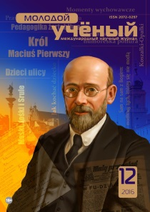Clay is a material that can be found almost in all places of the earth. Over millions of years rocks of different origin erode into microscopic small pieces that finally form clay. This clay can still be deposited in the place where it was developed or it can be transported through rivers to lower lying areas, even up to the sea. If water is blended to the clay the clay becomes plastic and can be molded into any shape. As this material is distributed all over the world it is not surprise that people everywhere use it since they detected how to make fire.
Beside clay and water fire is the third element to produce ceramic. Most probably it was somewhere in middle East when people first detected that the soil where they had made a fire to prepare their food or to warm themselves has changed it's color from brown to red and became very hard! Ceramic and the use of clay were detected!
Through this people had found a way to boil and store food – an important step to settle and to leave the stage of being nomads. It is not a surprise that this important step together with the fact that clay was abundant everywhere resulted in a worldwide use of clay. We can find thousands of years old ceramic artifacts everywhere where people settled.
Now in the 21st century clay is a material that is used for many applications: cook ware, dinner ware, food storing containers, and decorative ceramics are well known to be made from clay. But special kinds of clay for instance are used for different kinds of cosmetics. Clay also has a medical value for curing and for replacement of teeth and bones. Some of the technical applications are pistons in motors, screws, and knives that stay much longer sharp compared to the best metal.
1. Initial Situation
From February 28 to March 20, 2016 I was invited through the German Senior Expert Service by Humanitarian College named after M. Mametova to teach 4 teachers of the Art Department the basics needed to operate a small pottery workshop in the college. This workshop is intended to teach students how to use clay for art projects as well as for commercial goods. The workshop is also intended to provide products for local and national celebrations and events, like the EXPO 2017.
Upon my arrival the workshop was equipped with state of art basic equipment:
1 electric potters wheel (Shimpo brand), 1 electric kiln with a firing capacity of 140 liter (Nabertherm brand), 1 electric pug mill (Shimpo brand), 1 clay blender (Festo brand), and 1 small filter press. Few initial tools for modeling were also at hand. Most of the machines were not yet activated and part of my consultancy was to teach the use and operation of these machines. There was a small volume of red plastic clay as well as a small amount of red raw clay from Turkestan on stock. This was brought by a potter from Turkestan who has held a 2 day seminar about clay preparation and throwing on the potter’s wheel some time ago. Before my arrival the college also bought 10 tons of dry white clay from a ceramic factory in Ukraine. This clay was used for slip casting.
As glazes for ceramic are not available in Kazakhstan I tried to send a selection of glaze samples ahead of my arrival by a forwarder but I could not push through with this idea as the requirements of the customs could not be solved by the supplier. Therefore, I decided to bring a few glaze samples in order to be able to transfer at least some basic knowledge about glazing.
Based on this initial situation it was clear for all involved that within these 3 weeks the focus needed to be on a systematic approach to teach the minimum basics of ceramic production in terms of forming, decorating, and firing.
2. Tools
For the modeling of ceramic not many tools are needed – and many of them can be sourced in the local market or even made by yourself. Some plastic container for clay and glazes, wooden kitchen tools can be adjusted to mold clay – there is no limit for the fantasy to use existing items for clay modeling. Even and old tooth brush or an invalid credit card is helpful. The biggest challenge was the making of a cutting tool for “leather hard” clay. For this we needed a thin, small and very hard band of steel. Years ago potters used for this the spring of an alarm clock, the old type that needed to be wind up by hand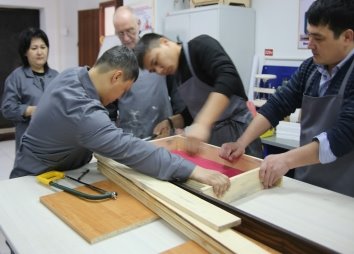 . But nowadays when everyone is using the smart phone it is difficult to find this spring. But with some effort we were able to find this kind of spring!
. But nowadays when everyone is using the smart phone it is difficult to find this spring. But with some effort we were able to find this kind of spring!
3. Flow of work – clay preparation
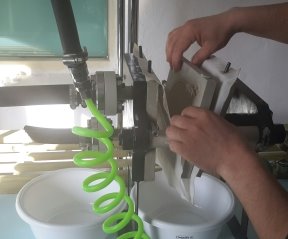 We had some clay samples available from Turkestan and Kyzylorda. The clay taken from the soil can not be used right away for modeling. First the clay needs to be dried, and then soaked in water to make a liquid slip. This slip needs to be passed through a fine screen to remove the natural impurities like stones, wood, and roots. After this we need to remove the excess water to get the state of plasticity. This can be done in different ways from drying the slip in the air or in gyps containers. A modern method to remove the water is a filter press. For demonstration purposes a filter press in laboratory size is available in the pottery shop of the college. I taught how to operate this filter press.
We had some clay samples available from Turkestan and Kyzylorda. The clay taken from the soil can not be used right away for modeling. First the clay needs to be dried, and then soaked in water to make a liquid slip. This slip needs to be passed through a fine screen to remove the natural impurities like stones, wood, and roots. After this we need to remove the excess water to get the state of plasticity. This can be done in different ways from drying the slip in the air or in gyps containers. A modern method to remove the water is a filter press. For demonstration purposes a filter press in laboratory size is available in the pottery shop of the college. I taught how to operate this filter press.
4. Flow of work - modeling
To make ceramic in high quality requires a well defined flow of work that needs to be followed. Usually we need two to three weeks from the start until a product is finished. After preparing the clay we start molding, and for most of the products we can not mold an item from the begin to the end but we have to interrupt the work and let the clay dry up to a specific moment that we need to continue the molding. When the molding is finally finished the clay has to dry carefully and not to fast to avoid cracks. These cracks easily develop as the clay shrinks during drying. After the clay is completely dry it can be fired in the kiln. This also takes 1 day and often a second day for cooling down before we can open the kiln. To do this within 3 weeks is a real challenge!
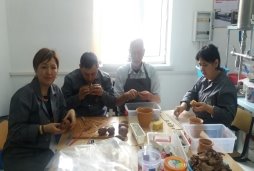
Therefore we started the first project immediately after we prepared the basic tools. This project was the production of an ocarina, a traditional flute that was invented originally in Asia. The modeling of an ocarina served as a sample to explain and learn: where does the plasticity of clay come from, what is the right moment in terms of plasticity to do the steps of work, how do we cut and connect clay in the right way, and how can we decorate clay by carving. As pattern for the carving decoration traditional Kazakh patterns were used. For all the steps of work we worked out the theoretical background as it is necessary not only to understand how we do it but also why we do it in a certain way. Only with this background the student can work later on independent from the teacher.
Of course most important in the production of an ocarina is the sound. Everyone was happy to hear his ocarina singing – after some trial and error and sometimes a little disappointment! To hear this first sound of ones ocarina is a big pleasure - but the next challenge is to tune the ocarina to play correct scales, and then there is the next challenge to tune ocarinas in that way, that they can play in a small orchestra. This shows making ceramic is not an instant coffee! One participant of the teachers group concentrates now on the making of ocarinas to master this field.
Another method to mold clay is the slab method. We cut slabs of clay in the desired thickness and size with the help of equal sized sticks. We practiced this method to make many slabs for our glaze and engobe samples, see the later chapter about decoration. The slabs need to be dried until they are leather hard. Then we can cut them into the desired size and combine them to any shape. We can use this method for instance to make a high rectangular vase. Connecting two pieces of clay is a process that needs to be carried out with care to avoid cracking at the joint during drying.
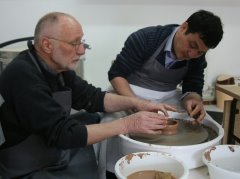 The third method of modeling that we took up was the throwing on the potter’s wheel. When you see a potter working on his wheel making a vase, a bowl or a plate his work looks so easy. But the way to reach this perfection is so long! First you have to master the centering of the clay in the middle of the potter’s wheel. Next is the opening of the clay, going down in the center of the clay until you reach the bottom, then widening the bottom part and finally pulling up the clay wall to form a little bowl. You only start with about 200g of clay – your bowl will be just good for some peanuts during your next TV evening! When this is mastered we can slowly increase the weight of the clay used in steps of 100g. I guess it becomes clear already that throwing on the potter’s wheel requires a long and steady training. Expect that it might take more or less 6 month before a beginner can make bowls of 20cm in diameter or vases of 20cm in height that look the same. 6 month of daily intensive training!
The third method of modeling that we took up was the throwing on the potter’s wheel. When you see a potter working on his wheel making a vase, a bowl or a plate his work looks so easy. But the way to reach this perfection is so long! First you have to master the centering of the clay in the middle of the potter’s wheel. Next is the opening of the clay, going down in the center of the clay until you reach the bottom, then widening the bottom part and finally pulling up the clay wall to form a little bowl. You only start with about 200g of clay – your bowl will be just good for some peanuts during your next TV evening! When this is mastered we can slowly increase the weight of the clay used in steps of 100g. I guess it becomes clear already that throwing on the potter’s wheel requires a long and steady training. Expect that it might take more or less 6 month before a beginner can make bowls of 20cm in diameter or vases of 20cm in height that look the same. 6 month of daily intensive training!
The forth method for molding is to prepare a gyps mold from an original sculpture of any shape. This gyps mold can be used afterwards to form clay sculptures. This method is economically interesting as it is comparatively fast in production. We applied this kind of production for a sculpture of Korkyt Ata and for a relief. We introduced it also for the molding of 2 sizes of ocarinas. This gives us the opportunity to get ocarinas of exactly the same size. That is important as the tune of the ocarina varies with the size. The smaller the ocarina the higher is the tune.
5. Flow of work – drying
During drying the clay will shrink. Shrinkage can be up to 10%. If the molded ceramic will not dry equally it will also not shrink equally which will result in deforming the item. Also in some cases we have to dry the ceramic until a defined state of dryness to continue the work. All this means that the drying process needs to be handled with a lot of knowledge and experience. The shrinkage also continues during firing, the extend of the shrinkage depends on the firing temperature.
At this point we had to revive some math knowledge from our school times. The challenge is to calculate the size of an item that we have to mold if this item needs to have a defined size after the production process. As this shrinkage is different for all clays and as it is also depending on the firing temperature we started to make small slabs for testing purposes. This testing needs to be done for all kind of clays that are used in a pottery.
6. Flow of work - 1st and 2nd firing
Clay only can be fired when completely dry. Usually 2 firings are made, the first firing at a temperature of 900°C to 950°C. This firing is called biscuit firing. During this firing some chemical transformations of the different clay components take place that transforms the clay to ceramic. The most important of these chemical processes in terms of save firing is the so called quartz jump. Quartz is a component in all clays. At 575°C the quartz expands – this is called the quartz jump. Therefore the firing needs to be done a little slowly until we reach this temperature. As a rule of thumb we usually do the increase of temperature up to 600°C within 6 hours.
The college is equipped with a state to art electric kiln build with energy saving materials and equipped with an electronic controller to configure the firing curve needed. Therefore I spend some time to teach how the controller needs to be configured to automatically conduct the firing. But even more important was to tech the process that makes the changes in the clay to become ceramic. It is always important to understand the process beyond pressing some buttons!
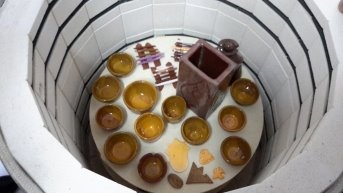 For glazed ceramic we need a 2nd firing, called glaze firing. After the biscuit firing we can apply the glaze – usually by dipping the biscuit fired items into a glaze. Then these items are fired up the specific glaze that is needed to melt the glaze.
For glazed ceramic we need a 2nd firing, called glaze firing. After the biscuit firing we can apply the glaze – usually by dipping the biscuit fired items into a glaze. Then these items are fired up the specific glaze that is needed to melt the glaze.
As the firings are energy intensive we only should fire kilns that are loaded with their full capacity. But due to the limited time during my consultancy we had to make an exemption and do firings with few items. I also taught the necessary steps for the maintenance of the kiln as this is high developed equipment and spare parts maybe difficult to get in Kazakhstan.
7. Decorating ceramic
People do not only want to have functional things but they also want to have them designed in a nice way. In ceramic we often can find small pieces of simple decoration on containers like water jars since thousands of years. Potters liked to decorate their work with simple lines or scratches, sometimes just with a lively finger scratch.
In archeological sites we can find decorated ceramic anywhere in the world. Simple decoration was used for ordinary people while for high ranking people, leaders or for special occasions rich decorated ceramic was made. Before the technique of glazing was invented the ceramic was carved or clay with another color was applied on the surface of the items to paint ornaments for decoration.
Nowadays we have a wide range of decoration methods, from carving like in the old days up to high tech applications for instance through screen printing. During the consultancy we took up carving, slip decoration with an engobe, and glazing.
As said before carving and scratching are the oldest methods to decorate ceramic. After molding the items the clay is still too soft to apply this method. Therefore the clay needs to dry until a certain stage that is called leather hard. With tools like knives, wood sticks etc. we can carve the clay to apply any shape of the desired design. In all cultures the potters often applied patterns that you also can find for instance in weaving. Instead of carving the leather hard clay it also can be stamped with ceramic or gyps stamps that will impress the desired pattern in the clay. For this the clay needs to be a little softer than leather hard. Potters make the tools used for carving themselves to get the desired shape.
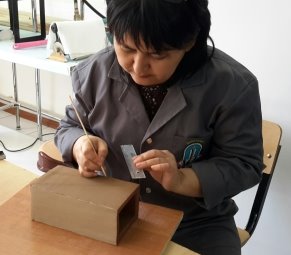 An engobe is liquid clay that is applied on the leather hard surface of an item. This engobe shall be of another color than the items itself. For instance we apply an engobe that is made from white clay on the surface of an item that is made from red clay. When the engobe is dried for a while we can carve the surface and the red clay will appear. Using this method we can draw on clay! To prepare engobes we can use clays of different firing colors and even mix different clays to get a wide range of colors. If metal oxides are available the range of colors can be extended widely if we add these oxides to an engobe made from white clay. The oxide from cobalt is used to make a blue engobe, copper and chromium oxide will give us different shapes of green, iron oxide is used to make red, yellow and brown colors - and many more.
An engobe is liquid clay that is applied on the leather hard surface of an item. This engobe shall be of another color than the items itself. For instance we apply an engobe that is made from white clay on the surface of an item that is made from red clay. When the engobe is dried for a while we can carve the surface and the red clay will appear. Using this method we can draw on clay! To prepare engobes we can use clays of different firing colors and even mix different clays to get a wide range of colors. If metal oxides are available the range of colors can be extended widely if we add these oxides to an engobe made from white clay. The oxide from cobalt is used to make a blue engobe, copper and chromium oxide will give us different shapes of green, iron oxide is used to make red, yellow and brown colors - and many more.
Glazes are made from different materials like feldspar, quartz, kaolin, whitening, special kind of clays, metal oxides and so on. It is a wide range. Usually the application of the glazes is done after the biscuit firing, then the items are fired a second time with the temperature required to make the glaze components melt on the surface. Firing temperature of glazes can be from about 1000°C up to more than 1300°C. For the higher temperatures we need to take the clay of the items into consideration as not all clays can withstand higher temperatures beyond 1050°C. Only few glaze samples that I brought from Germany could be used to explain and practice the main process of glazing and glaze firing. While searching in Kyzylorda for material we found a shop that had one kind of glaze on stock. We were excited to see the result of our effort when we opened our first glaze firing on March 16! And we were so happy when we saw the colorful result. Everything went well – we almost couldn’t believe.
8. Product ideas
As mentioned above, we also had the plan to develop some product ideas during the consultation. The developing of ocarina flutes was described already.
As one of the participating teachers is a sculpturer it was easy to decide to develop one product group in his professional field. As a first sample, we produced a three dimensional sculpture of Korkyt Ata as well as a relief. The specific problems of clay sculptures was discussed and trained.
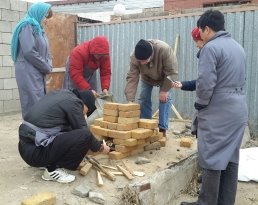
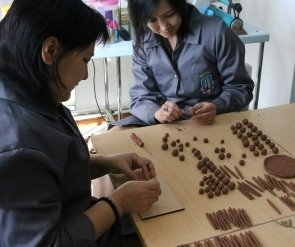 While ocarina and sculptures are not completely new product groups the next product is. We developed different ideas for jewelry made from clay. These can be bracelets, necklace, and broches. As we had only few glaze samples available and the future supply of glaze is not secured, we concentrated on possibilities to get a range of earthen colors through blending different clays and applying different firing temperatures. We also conducted a firing in a simple small wood firing kiln that we constructed within an hour with 60 pieces of bricks. This kind of firing gives us another range of colors compared to the firing in an electric kiln. As this kind of firing is basically the same that is used in the past it would be an option to produce replicas from ancient ceramic to develop new products that are based on ancient ceramic but adjusted to modern times.
While ocarina and sculptures are not completely new product groups the next product is. We developed different ideas for jewelry made from clay. These can be bracelets, necklace, and broches. As we had only few glaze samples available and the future supply of glaze is not secured, we concentrated on possibilities to get a range of earthen colors through blending different clays and applying different firing temperatures. We also conducted a firing in a simple small wood firing kiln that we constructed within an hour with 60 pieces of bricks. This kind of firing gives us another range of colors compared to the firing in an electric kiln. As this kind of firing is basically the same that is used in the past it would be an option to produce replicas from ancient ceramic to develop new products that are based on ancient ceramic but adjusted to modern times.
At the time of the consultancy it is still too early to talk about products that are made on the potter’s wheel as the training for this production method has only just started. It takes many months before we can talk about a quality products made on the potter’s wheel.
9. Where is the future?
I hope this little article made clear also for the reader that had no knowledge about ceramic before the production of ceramic is a wide field. On the long way to master the clay there is a lot of patience needed, disappointments are ahead and new challanges always cross our way. But there are also these moments of happiness when we finally have achieved something that we worked for hard. And what a satisfying moment on a day of hard work when can look at our products of the day. Not many professions have this. Or the exitement when we open the kiln to finally see he results of our weeklong efforts. Were we successfull or did we fail? Yes, sometimes we are disappointed when we open the kiln but most of the time we are so glad and happy to see what we worked for.
Making creamic is not just a profession to earn money. We must be devoted to the work, have interest for the tradtion, and must have the power to develop our own creativity. Only with this power we will become a master in our profession. But I think, this is the case for everyone in his specific field of work, isn´t it?
Personally for me it was always a proud feeling that I worked in a long tradition of mankind. I worked with the same materials as our forefathers thousands of years ago. Basically just in the same way: clay, water, fire. And I always felt that our generation has to pass the knowledge to the next generation.
In this sense it is a wise cultural decision for the Kyzylorda Humanitarian College named after M. Mametova to include pottery into the curriculum. Headmaster Abdukalikova Alima Zhakipovna gives a great opportunity to the youth to become a tiny part of the long pottery tradition that they will be able to lead this tradition to the future. This opportunity can not be overestimated.






